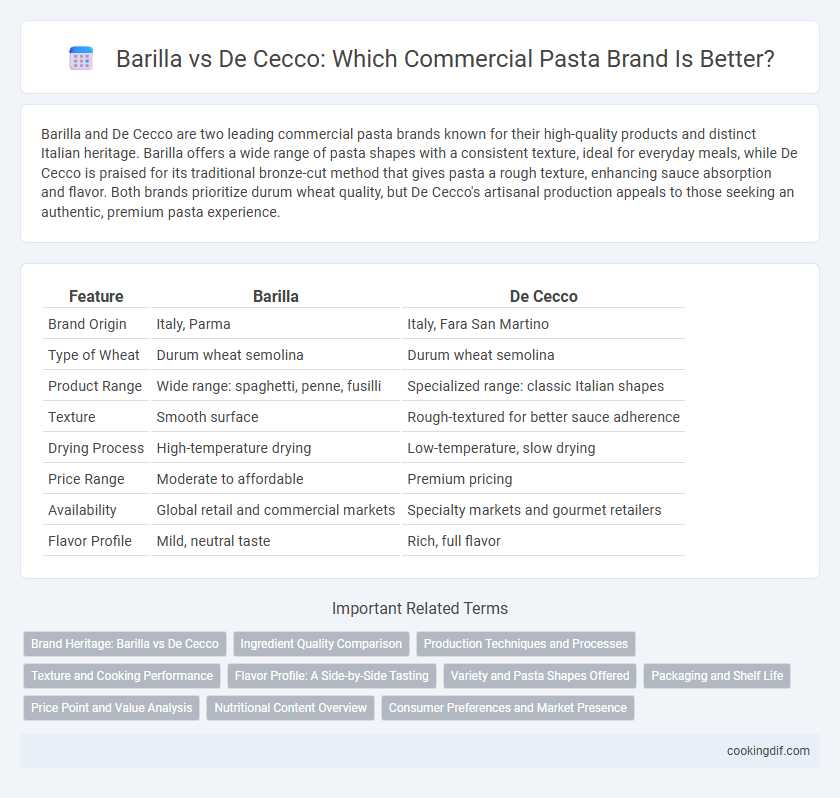Barilla and De Cecco are two leading commercial pasta brands known for their high-quality products and distinct Italian heritage. Barilla offers a wide range of pasta shapes with a consistent texture, ideal for everyday meals, while De Cecco is praised for its traditional bronze-cut method that gives pasta a rough texture, enhancing sauce absorption and flavor. Both brands prioritize durum wheat quality, but De Cecco's artisanal production appeals to those seeking an authentic, premium pasta experience.
Table of Comparison
| Feature | Barilla | De Cecco |
|---|---|---|
| Brand Origin | Italy, Parma | Italy, Fara San Martino |
| Type of Wheat | Durum wheat semolina | Durum wheat semolina |
| Product Range | Wide range: spaghetti, penne, fusilli | Specialized range: classic Italian shapes |
| Texture | Smooth surface | Rough-textured for better sauce adherence |
| Drying Process | High-temperature drying | Low-temperature, slow drying |
| Price Range | Moderate to affordable | Premium pricing |
| Availability | Global retail and commercial markets | Specialty markets and gourmet retailers |
| Flavor Profile | Mild, neutral taste | Rich, full flavor |
Brand Heritage: Barilla vs De Cecco
Barilla, founded in 1877 in Parma, Italy, is renowned for its long-standing tradition of quality pasta production and global market leadership. De Cecco, established in 1886 in Abruzzo, Italy, emphasizes artisanal craftsmanship and the use of traditional drying processes, preserving authentic Italian flavors. Both brands leverage rich heritage to appeal to consumers seeking premium and culturally rooted pasta products.
Ingredient Quality Comparison
Barilla sources Italian durum wheat known for its high protein content, ensuring firm pasta texture, while De Cecco emphasizes traditional milling techniques that preserve the wheat's natural nutrients and gluten strength. De Cecco often uses bronze dies to create a rougher pasta surface that helps sauce adhesion, reflecting their commitment to ingredient and process quality. Both brands maintain strict quality controls, but De Cecco's artisanal approach contrasts with Barilla's industrial scale, appealing to consumers prioritizing ingredient authenticity.
Production Techniques and Processes
Barilla employs advanced extrusion technology combined with rigorous quality control systems to ensure consistent pasta texture and durability, while De Cecco emphasizes a slow-drying process at lower temperatures that preserves the wheat's natural flavor and texture. Barilla's use of modern machinery allows for large-scale production efficiency, whereas De Cecco retains traditional bronze die extrusion, creating a rougher surface that improves sauce adherence. Both brands source high-quality durum wheat but distinguish themselves through unique production techniques that influence their pasta's cooking performance and taste profiles.
Texture and Cooking Performance
Barilla pasta offers a consistent texture with a smooth surface that allows even cooking, making it ideal for everyday meals. De Cecco pasta features a rougher texture due to bronze die extrusion, which enhances sauce adhesion and delivers a firmer bite preferred in gourmet dishes. Both brands excel in cooking performance, but De Cecco maintains firmness longer, appealing to those seeking al dente precision.
Flavor Profile: A Side-by-Side Tasting
Barilla pasta features a mild, slightly nutty flavor with a smooth texture that complements a wide range of sauces, making it versatile for everyday meals. De Cecco offers a richer, more pronounced wheat taste with a firmer bite, attributed to its traditional bronze-drying method which enhances sauce adherence. Taste tests reveal De Cecco's robust flavor appeals to pasta connoisseurs seeking quality, while Barilla's balanced profile suits those who prefer subtlety and consistency.
Variety and Pasta Shapes Offered
Barilla and De Cecco both offer extensive selections of pasta varieties, with Barilla providing over 50 different types, including classic shapes like penne, spaghetti, and fusilli, alongside specialty options such as gluten-free and whole grain pasta. De Cecco emphasizes traditional Italian craftsmanship, offering a broad range of shapes like orecchiette, rigatoni, and trofie, known for their quality and texture suited for specific regional sauces. The diversity in pasta shapes and innovative options make Barilla ideal for mass-market versatility, while De Cecco appeals to consumers seeking authentic, artisanal pasta experiences.
Packaging and Shelf Life
Barilla and De Cecco are two leading commercial pasta brands with distinct packaging approaches impacting shelf life and consumer appeal. Barilla utilizes airtight, resealable plastic packaging that preserves freshness and extends shelf life up to two years, facilitating convenient storage. De Cecco prefers traditional cardboard boxes with inner plastic linings, offering slightly shorter shelf life but emphasizing eco-friendly materials and premium quality perception.
Price Point and Value Analysis
Barilla offers a competitive price point with a wide range of pasta products that balance affordability and quality, making it a preferred choice for budget-conscious consumers in commercial settings. De Cecco, while positioned at a slightly higher price, delivers premium value through its traditional bronze-die extrusion process and superior texture, appealing to markets prioritizing authentic quality. Analyzing value, Barilla's extensive product variety and cost-efficiency cater well to mass distribution, whereas De Cecco commands loyalty in gourmet segments due to its artisanal production and refined flavor profile.
Nutritional Content Overview
Barilla and De Cecco, two leading commercial pasta brands, both offer products rich in carbohydrates and low in fat, supporting sustained energy release and heart health. Barilla pasta typically contains around 200 calories, 42 grams of carbohydrates, 7 grams of protein, and less than 1 gram of fat per serving, while De Cecco's pasta features similar macronutrient profiles with slightly higher protein content, often reaching 8 grams per serving. Both brands provide essential micronutrients such as iron and B vitamins, contributing to overall nutritional balance in a pasta-based diet.
Consumer Preferences and Market Presence
Barilla dominates global market presence with extensive distribution in over 100 countries, while De Cecco holds a premium niche appeal emphasizing traditional Italian craftsmanship and quality. Consumer preferences often lean toward Barilla for affordability and variety, whereas De Cecco attracts those seeking artisanal texture and flavor nuances. Brand loyalty within commercial pasta sectors reflects Barilla's broad accessibility contrasted with De Cecco's reputation for authenticity and superior ingredient sourcing.
Barilla vs De Cecco for commercial pasta brands Infographic

 cookingdif.com
cookingdif.com